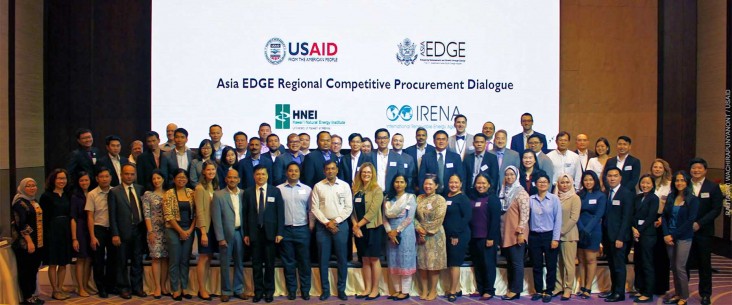Speeches Shim

This three-day event introduced participants to advanced procurement trends and helped them develop new skills in designing and modifying renewable energy competitive procurements.
USAID supports partner countries on their journey to self-reliance by helping design and implement auctions that can rapidly scale clean energy at low prices and advance national economic and clean energy goals. USAID provides support for auctions through bilateral and regional energy programs and a variety of programs managed out of Washington, D.C.
USAID hosted the “Asia EDGE (Enhancing Development and Growth through Energy) Regional Competitive Procurement Dialogue” in Bangkok, Thailand, November 18–20, 2019. Asia EDGE is a United States Government initiative that grows sustainable and secure energy markets throughout the Indo-Pacific region. Under Asia EDGE, USAID is promoting transparent competitive procurement, enabling countries to understand and adopt frameworks to match technology and market maturity.
The Asia EDGE workshop sessions covered the following topics:
- Key design elements;
- Creating competitive procurement packages and bankable contracts; and
- Advanced competitive procurement elements.
The dialogue illustrated the benefits of competitive procurement in a South and Southeast Asian context, with many countries in the region in a period of transition from feed-in tariffs (FIT) to introducing competitive procurement. The dialogue also helped prepare participants to hold competitive procurement rounds in the near term and enabled them to design a competitive procurement according to their country specifications.
During the event, speakers shared experiences from the implementation of successful competitive procurements in Brazil, India, and Hawaii. Country delegates included staff from utilities, ministries, planning offices, power purchase agreement offices, system operators, market operators, and regulators.
Open, transparent renewable energy competitive procurement, coupled with declining prices for solar and wind technologies, have facilitated billions of dollars of investment at record low prices all over the world through market price discovery. Those who implement and oversee renewable energy competitive procurement processes can gain new skills from these presentations.
Day One
Workshop Introduction (PPTX 6MB)
USAID opened the workshop with an overview of the workshop’s agenda and learning objectives, USAID’s experience in competitive procurement, and USAID’s building-block approach to scaling up renewable energy.
Global Trends in Competitive Procurement (PDF 2MB)
The International Renewable Energy Agency (IRENA) provided an overview of auction price trends worldwide, factors that affect auction prices, and how auction design and supportive policies can help achieve other objectives such as system integration and an inclusive energy transition.
Renewable Energy Grid Integration Challenges and Solutions (PPTX 6MB)
The Hawaii Natural Energy Institute (HNEI) discussed grid integration solutions in Hawaii, including timely renewable energy grid integration analysis and planning and regular updates of grid codes and inverter performance requirements.
Auctions and Market Structure (PPTX 3MB)
Thymos Energia presented on the importance of considering the structure of the electricity market, the type of demand, and suitable technology requirements for renewables in the design of competitive procurement programs.
Evolution of Procurement in India’s Auctions (PPTX 6MB)
USAID/India gave an overview of the Government of India’s plans for procurement and India’s power procurement evolution, including examples of the auction design approaches tested at the central and state level to achieve competitive prices, procure more dispatchable renewables, and improve the bankability of the power off-taker.
Auction Design—Part 1 (PPTX 2MB)
Navigant presented on the definition and advantages of auctions, the importance of tailoring auction design to local market and regulatory conditions, and design options regarding project site selection and prequalification requirements for project developers.
Auction Design—Part 2 (PPTX 2MB)
Navigant provided an overview of design options and country experiences related to defining ceiling prices, financial guarantees, and penalties for non-compliance with contractual obligations.
Day Two
Developing a Procurement “Package” of Tools (PPTX 3MB)
Navigant discussed how tender documents, including power purchase agreements, set the implementation framework for auction programs. The presentation also addressed how balanced risk allocation between power buyers and sellers is key in achieving competitive auction prices and high project realization rates.
Brazilian Power Auctions (PPTX 4MB)
Thymos Energia provided an analysis of strengths, weaknesses, opportunities, and threats drawn from Brazil’s experience with renewable auctions. The presentation included lessons relevant for countries at different stages of auction implementation in Southeast Asia.
Renewable Energy Resource Procurements in a High-Penetration Grid—Hawaii Case Study (PPTX 3MB)
HNEI presented on the evolution of procurement practices, the risk balance between buyers and sellers of power in power purchase agreements, bankability assurance, and the drive to lower costs in Hawaii, where a 100 percent renewable energy portfolio standard is driving rapid change.
Ensuring a Just and Inclusive Transition (PDF 2MB)
IRENA presented lessons on how renewable energy competitive procurement design impacts inclusion of small and new players, the development of local industries, subnational development, and community benefits, as well as local job creation.
Day Three
Thailand’s Experiences with Renewable Energy Feed-In Tariff Schemes (PDF 505K)
The Ministry of Energy of Thailand presented lessons learned in Thailand on renewable energy competitive procurement, including an auction for renewable capacity with peak and off-peak delivery obligations.
Renewable Energy Business in Indonesia (PDF 3MB)
The Ministry of Energy of Indonesia provided an overview of the state of Indonesia’s energy sector, government policies and regulations, and plans for renewable energy projects.
Key Auction Lessons and Case Studies for Mexico and Japan (PDF 3MB)
IRENA analyzed the context and motives for introducing auctions in Mexico and Japan, key design elements and outcomes, implementation challenges, lessons learned, and the outlook for auctions.
Advanced Auction Design Elements (PPTX 2MB)
Navigant provided an overview of design solutions, such as time-based incentives, physical and virtual hybrids, and location-based incentives, to increase system integration of renewable energy. The presentation included an analysis of the experience and motivation of countries testing these design solutions.
Introduction to the Renewable Energy Data Explorer: Southeast Asia and Nepal (PDF 581K)
USAID Clean Power Asia introduced a map-based platform for renewable energy data visualization to support planning and policy decision-making.
Utility-Scale Storage Economics in Auctions (PPTX 4MB)
Climate Economic Analysis for Development, Investment, and Resilience (CEADIR) provided an overview on the rationale for battery energy storage systems (BESS) to facilitate the market and system integration of renewable energy and analyzed the experience of countries that included BESS in renewable auctions.


Comment
Make a general inquiry or suggest an improvement.